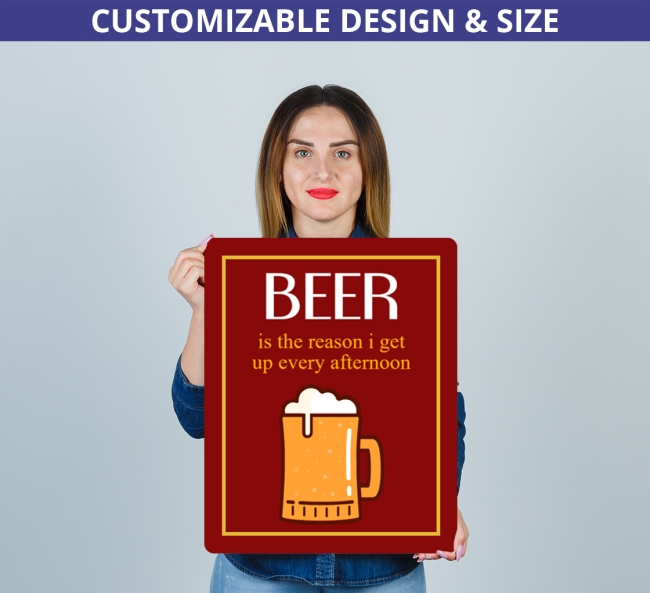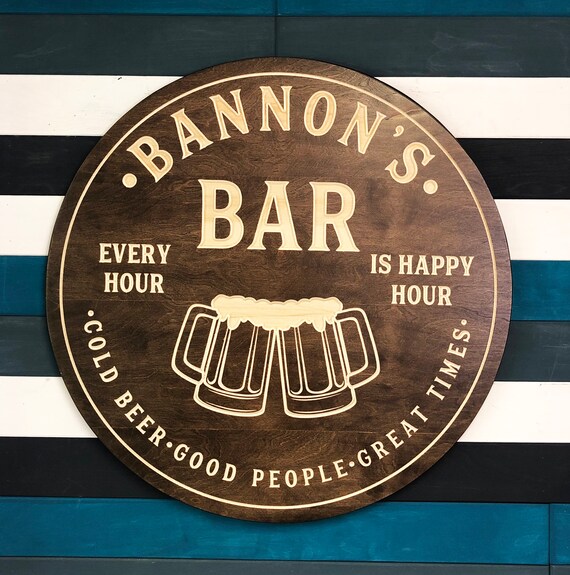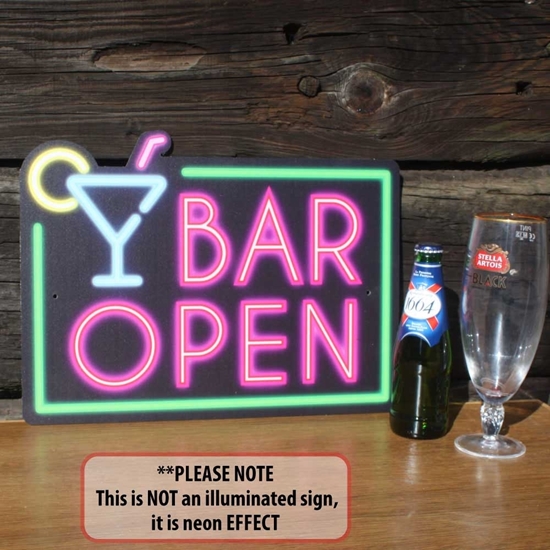Handy Info To Picking Bar Signs
Handy Info To Picking Bar Signs
Blog Article
What Is The Difference Between Bar Sign Sizes?
Bar signs differ in size and style based on their function, location, and the overall design aesthetic. The following are the ways that different sizes affect bar signs in terms of functionality and design. Large Signs
The purpose is to draw the attention of others and act as an important focal area.
Signage for exterior use or main branding signs.
Placement - Most often placed outside, above large entrances, or on walls with large openings to attract customers.
For instance, large neon signs, vintage or large mural-type signs.
2. Medium Signs
Goal: To give information or to enhance the decor without dominating the space.
Applications: menu boards, displays for promotions and directional signs.
Placement: Positioned so that it is easily visible but not overwhelming.
For instance chalkboards of medium size with daily specials or metal signs with the bar's logo.
3. Small Signs
Use to create particular details or subtle details.
Applications: Small, decorative pieces or labels.
Placement on shelves, tables or displays for close-up views.
For example, Table number signs, or even small frames with quotes.
Size Aspects
Visibility
Large Signs: Made to be seen from a distance, making them ideal for attracting passersby and establishing the bar's presence.
Medium signs balance visibility and space efficiency to provide important information without overwhelming the décor.
Small Signs (small signs): These are ideal for intimate and close-up information that are displayed at eye level.
Proportion
Large Signs: They should be proportionately big so as to not overwhelm smaller areas. Most suitable for open or spacious environments.
Medium Signs: Perfect for interior use They can be put anyplace.
Small Signs: Ideal for adding detailed touches and fitting into tighter spaces without cluttering.
Impact
Signs of a large size makes a bold and imposing statement. This can be an important factor in branding. Used to set the mood of the bar.
Medium Signs: Strikes the right balance between decor and visibility creating a welcoming ambience while delivering vital information.
Small signs (Signs) are a great way to add detail and a sense of humour to a visual experience.
Practicality
Large Signs: require substantial mounting solutions and can be more costly due to size and materials.
Medium Signs - Simple to move and install, with flexibility for design changes.
Small Signs are easy to replace and update, they are perfect for dynamic settings like bars where promotions or menus change frequently.
Functionality
Large Signs : They are designed to draw attention, make a statement and provide the ability to function.
Medium Signs: They're both decorative and functional. They are a source of vital information, but also enhance the aesthetics.
Small Signs are used to convey detailed information. They are also utilized to enhance the look of your theme.
The best size for bar signs will depend on the intended function of the sign, its location in the bar, and how it will be perceived by customers. The signs can contribute to the atmosphere and operation of the bar when they are well-balanced. Check out the recommended this hyperlink on window vinyl for more examples including design a pub sign, bar signs for home bar, personalised bar signs, large bar signs, to the bar sign, the staying inn pub sign, bar sign outdoor, make a bar sign, bar wall signs, personalised outdoor pub signs and more.
What Is The Distinction Between Bar Signposts And Other Signs In Light?
The bar signs differ greatly in terms of lighting, which can affect their ambiance, visibility and overall impact. Here are some of the ways in which lighting for bar signs may be affected Neon Signs
Characteristics: Bright, colorful, classic.
Lighting: Utilizes a fluorescent gas-filled tube that emits light when it is charged by electricity.
Uses: Create a retro style with this material. It is commonly used to design bar names, logos and other eye-catching designs.
Advantages: Visible even at a distance and is a touch of nostalgia.
It's fragile and repairs can be costly.
2. LED Signs
Characteristics: Energy-efficient, versatile, modern.
Lighting: LEDs produce bright, vibrant light.
Uses : Outdoor and indoor signs can be used, as well a programmable display and dynamic lighting effects.
Benefits: LEDs last a long time, are energy efficient, and they can be programmed with colors or animations.
Disadvantages: Can be expensive initially, but can save on maintenance and energy costs.
3. Backlit signs
Characteristics: Elegant, sophisticated, subtle.
Lighting: Utilizes LEDs or fluorescent lights behind a translucent surface to produce an ethereal glow.
Usage: Most often utilized on modern bar signs, menu boards, and branding elements.
Advantages: Professional and clean appearance, which improves readability in low lighting.
Advantages: More complicated installation and higher cost upfront.
4. Signs for Edge-Lit
Characteristics: Sleek, contemporary, stylish.
Lighting: Illuminates the edges of a sign usually acrylic, using LEDs.
Applications: Suitable for minimalist, modern designs. Useful for directional or informational signage.
Advantages: Creates an elegant and distinct appearance. It is energy efficient.
Advantages: Restricted to certain styles of designs.
5. Ambient/Accent Lighting
Characteristics: Subtle, atmospheric, decorative.
Lighting: Utilizes indirect lighting sources to emphasize or highlight signs.
Uses Improves the ambience. Often used to highlight artwork or themed decorations.
Benefits: It adds the ambience and depth, and can create a warm and warm atmosphere.
Disadvantages
6. Marquee Signs
Characteristics: Bold, theatrical, eye-catching.
Lighting: Has several light bulbs or LEDs around the edges of the sign.
Uses: Popular for creating vintage films and for creating exterior signage.
Advantages: Attractive and visible.
The drawbacks are that it can be expensive and requires regular maintenance.
7. Projection Signs
Characteristics: Dynamic, innovative, versatile.
Lighting Projectors: A device used for the projection of light and images onto a wall or other surface.
Uses : Great for temporary promotions, special events, and dynamic displays.
Benefits: There is no need to build an actual sign structure.
Negatives: Needs to be controlled lighting environment, and can not be as effective in bright environments.
8. Fluorescent Signs
Characteristics: Bright, cost-effective, traditional.
Lighting: Uses fluorescent tube to provide illumination.
Uses : Usually employed on large indoor and exterior signs.
Benefits: Effective and bright for large signage. It is relatively inexpensive.
Negatives
Tips for Lighting
Visibility
Neon and LED signposts: Great to draw attention from a distance.
Signs that are backlit or edge lit: Great for enhancing visibility and creating the appearance of polished.
Energy Efficiency
LED Signs: High-energy efficient. Durable.
Neon and fluorescent signs are less energy efficient as well as more fragile.
Aesthetic Appeal
Neon and Marquee Signs: Perfect for retro and vintage styles.
The ideal option for clean and modern designs are edge-lit signs with backlighting.
Ambient lighting: It enhances the ambience and overall mood.
Maintenance
LED signs are easy to maintain and long-lasting.
Signs with fluorescent or neon lights may require more frequent maintenance and repairs.
Cost
LED and Backlit Signs Higher upfront costs but lower operational costs.
Fluorescent Signs: Less initial cost, but more expensive long-term energy costs.
Flexibility
The Projection signs and LED signs provide a great deal of flexibility when it comes to changing the display and content.
Traditional Signs: They're more rigid, however they typically achieve a specific look.
Bar owners can enhance their bar's visibility and create the ambience they would like to create by selecting the correct type of bar sign lighting. They also have the ability to communicate their brand, promotions, and other details to patrons. Have a look at the top rated gin bar sign for site info including hanging pub signs for garden, pub signs for garden bar, hanging pub signs for sale, pub signs to buy, pub signs for garden, to the bar sign, pub sign hanging, pub signs to buy, the pub sign, personalised pub and more.
How Do Bar Signs Differ From One Another In The Area Of Interactivity?
Interactivity can be added to bar signs in a variety of ways to boost customer satisfaction and engage customers. Bar signs are classified based on the degree of interaction. Static Signs
Static signs offer information in a static format.
Common Types: Printed posters, murals painted, or standard neon signs.
2. Digital Displays
Digital signage provides instant updates and animations, as well as multimedia content.
Interactivity: Touchscreen displays can offer interactive menus, games, or promotional content.
Benefits : Draw attention to yourself through the presentation of dynamic information. Engage patrons.
3. QR Codes
QR Codes can be linked directly to social media profiles or menus.
Benefits: Provide quick access to information on promotions or loyalty programs.
4. LED Screens
Dynamic Messaging: LED screens may display animated scrolling text or video content.
Touch-enabled screens on LEDs allow viewers to interact with their contents. This includes selecting menu options or playing games.
Benefits: Attract attention, convey information effectively and provide an immersive experience.
5. Projection Mapping
Immersive experience Projection maps transform surface into dynamic displays and interactive images, allowing for storytelling.
Interactivity: Guests can interact with projected elements, such as virtual games, interactive ones or even.
Benefits: Enhance the ambience and social interaction while creating memorable experiences.
6. Augmented Reality (AR)
AR (Enhanced Reality) overlays digital content over the physical environment to provide interactive experiences.
Interactivity: AR-enabled signs let patrons to interact with virtual objects, for example viewing cocktail recipes or playing games in virtual reality.
Benefits: Reward patrons by engaging them and provide unique experiences to make your bar stand out.
7. Motion Sensors
Motion sensors sense movement to cause interactive signage to be activated.
Interactivity: Signs respond to patron movement by displaying animations, changing content, or providing specific messages.
Benefits include: Increasing the level of engagement, creating an immersive experience and enthralling patrons with unexpected and exciting experiences.
8. Social Media Integration
Internet Interaction: Posters that feature hashtags, or handles for social media could encourage patrons online interaction.
User-generated Materials: Inspire your patrons to post photos of the signs they see on social networks, thereby increasing the exposure and popularity of your bar.
Benefits include a higher feeling of community, a greater brand recognition and the creation of user-generated content.
9. Interactive Lighting
Interactive lighting: Signs equipped with LED or neon lights that react to touch or sound.
Signs become interactive when patrons interact or the environment is changed.
Benefits: Create a sense of ambiance and enhance the ambience and draw attention.
10. Gamification
Signs with interactive games or challenges that entertain patrons, and to encourage their participation.
You can offer discounts or incentives for completing tasks or games.
Benefits : Increases time of stay. Facilitate social interaction. Promote repeat visits.
Bar owners can create engaging experiences by including interactive elements into their signage. This can entice customers, increase brand awareness and help them differentiate themselves from the competition. Have a look at the best my explanation for window vinyl for more tips including hanging pub signs for sale, bar signs for home bar, home pub signs, the staying inn pub sign, bar signs for garden, pub signs personalised, pub signs for home bars, personalised metal pub signs, personalised metal bar signs, personalised home bar signs and more.